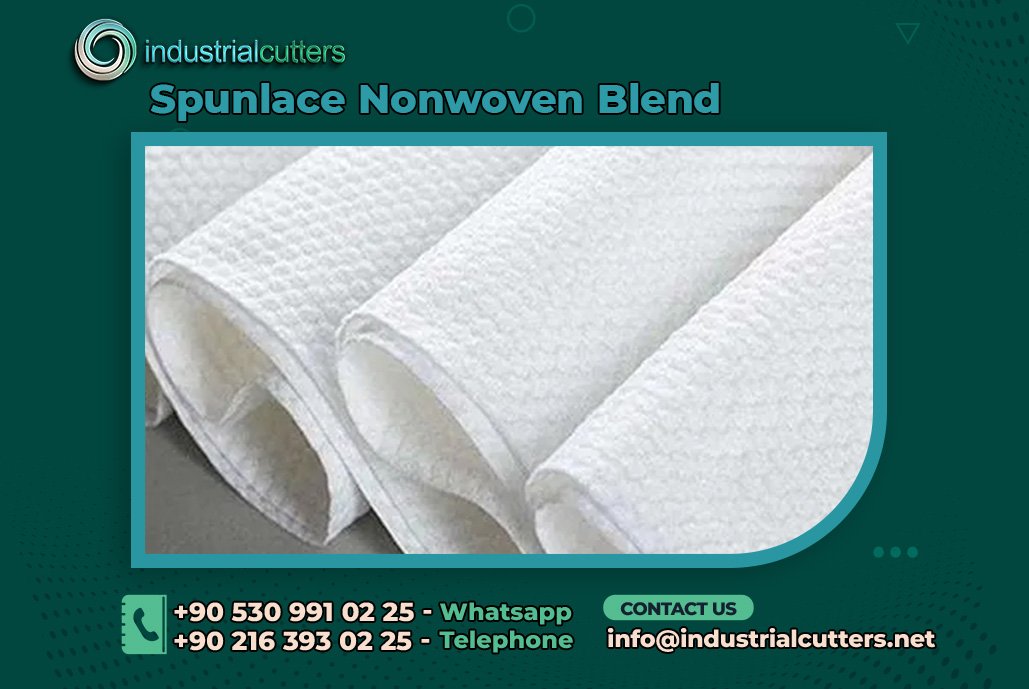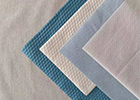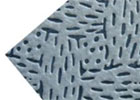Applications and Best Practices: Harnessing Spunlace Fabric for Industrial Use
|
Introduction to Spunlace Fabric in Industrial Use Best Practices for Using Spunlace Fabric in Industrial Applications Challenges and Solutions in Harnessing Spunlace Fabric for Industrial Use |
Introduction to Spunlace Fabric in Industrial Use
Enter the realm of spunlace fabric, also known as hydroentangled fabric—a nonwoven marvel that has swiftly ascended to stardom across diverse industrial landscapes in the United States. Imagine a versatile fabric crafted through the mesmerizing entanglement of fibers using high-pressure water jets. The result? A powerhouse material that boasts strength, absorbency, and cost-effectiveness, now prominently featured in sectors spanning automotive, healthcare, filtration, and beyond.
What is Spunlace Fabric?
This extraordinary fabric is born from a fusion of natural and synthetic fibers, a blend encompassing the richness of cotton, the resilience of polyester, and the elegance of rayon. The intricate dance of these fibers occurs through a mechanical process driven by high-pressure water jets. These jets weave a fabric tapestry that spells durability, softness, and remarkable absorbency. Furthermore, this entanglement process fortifies the fabric, rendering it a perfect fit for a wide array of industrial applications.
The true magic of spunlace fabric lies in its exceptional ability to efficiently absorb liquids, a trait that caters perfectly to industries demanding superior absorbency, such as healthcare and cleaning. But that's not all. The fabric's outstanding tear and abrasion resistance stand as a testament to its prowess, making it a sought-after choice for heavy-duty applications in various sectors.
Benefits of Spunlace Fabric in Industrial Applications
The use of spunlace fabric in industrial applications offers several benefits, including:
-
High Absorbency: Spunlace fabric has a unique structure that allows it to absorb liquids quickly and efficiently. This makes it ideal for applications such as wipes, medical dressings, and filtration media.
-
Soft and Gentle: Spunlace fabric is known for its softness, making it suitable for applications that involve direct contact with the skin. In industries such as healthcare and personal care, spunlace fabric is widely used in products like baby wipes, facial masks, and medical gowns.
-
Strength and Durability: Despite its softness, spunlace fabric is remarkably strong and durable. It can withstand rigorous usage and does not easily tear or fray. This makes it suitable for applications that require a long-lasting and reliable material, such as automotive components and industrial wipes.
-
Enhanced Cleanliness: Spunlace fabric is produced in a controlled environment, ensuring a high level of cleanliness and hygiene. In industries such as food processing and electronics, where contamination control is crucial, spunlace fabric is used to manufacture cleanroom garments, wipes, and filters.
-
Customizable Properties: Spunlace fabric can be tailored to meet specific industry requirements. By varying the fiber composition, density, and entanglement process, manufacturers can customize the fabric's properties, such as absorbency, strength, and filtration efficiency.
Best Practices in Using Spunlace Fabric for Industrial Applications
To fully harness the benefits of spunlace fabric in industrial use, it is essential to follow best practices, including:
-
Proper Material Selection: Identify the specific requirements of your application and select the appropriate spunlace fabric accordingly. Consider factors such as absorbency, softness, strength, and filtration capabilities.
-
Quality Assurance: Ensure that the spunlace fabric you use meets industry standards and specifications. Work with reputable suppliers who adhere to strict quality control measures.
-
Process Optimization: Collaborate with your fabric supplier to optimize the manufacturing process. This includes optimizing the water pressure, fiber composition, and entanglement process to achieve the desired fabric properties.
-
Continuous Improvement: Regularly evaluate the performance of spunlace fabric in your industrial applications. Collect feedback from end-users and make necessary adjustments to optimize functionality and cost-effectiveness.
-
Environmental Responsibility: Consider the environmental impact of your fabric choice. Look for suppliers that offer eco-friendly alternatives, such as recycled or biodegradable spunlace fabric.
In conclusion, spunlace fabric offers numerous benefits for industrial applications. Its high absorbency, softness, strength, and customizability make it a versatile material for industries ranging from healthcare to automotive. By following best practices and selecting the right fabric, businesses can effectively harness the advantages of spunlace fabric in their industrial operations.

Best Practices for Using Spunlace Fabric in Industrial Applications
When it comes to industrial applications, utilizing the right materials is crucial for maintaining efficiency, productivity, and safety. Spunlace fabric is an increasingly popular choice due to its versatility, durability, and ease of use. In this article, we will explore the best practices for using spunlace fabric in industrial settings, including choosing the right fabric for specific needs and proper handling and care.
Choosing the Right Spunlace Fabric for Specific Needs
Not all spunlace fabrics are created equal. Depending on the specific requirements of your industrial application, you need to consider certain factors before selecting the right fabric:
-
Strength and Durability: Assess the strength and durability requirements of your application. Spunlace fabrics with higher tensile strength and tear resistance are ideal for heavy-duty applications.
-
Absorbency: Evaluate the absorbency needs of your application. Some industrial processes require higher absorbency to efficiently manage liquids and control contamination.
-
Chemical Compatibility: Consider the chemicals and substances that the fabric will come into contact with. Ensure that the spunlace fabric is compatible with these chemicals to avoid degradation or contamination.
-
Linting: In some industries, the presence of lint can be detrimental to the production process. Opt for low-lint or lint-free spunlace fabrics to maintain cleanliness and minimize any risks associated with linting.
-
Specialty Features: Depending on your specific application, certain specialty features may be required. These can include flame resistance, antimicrobial properties, static dissipation, or heat resistance. Select a spunlace fabric that offers the necessary specialty features for optimal performance.
By carefully considering these factors, you can choose a spunlace fabric that best suits your industrial needs and ensures long-lasting performance.
Proper Handling and Care of Spunlace Fabric in Industrial Settings
To maximize the lifespan and effectiveness of spunlace fabric in industrial applications, proper handling and care are essential. Here are some best practices to follow:
-
Storage: Store spunlace fabric in a clean, dry area, away from direct sunlight and extreme temperatures. Proper storage prevents degradation and maintains the fabric's integrity.
-
Handling: Handle spunlace fabric with clean hands or wear suitable gloves to prevent contamination. Avoid dragging or rubbing the fabric against rough surfaces, as this can cause damage.
-
Cleaning: Regularly clean the spunlace fabric according to its specific requirements. This may involve machine washing, rinsing, or using specialized cleaning agents. Follow the manufacturer's instructions to ensure proper cleaning protocols.
-
Inspection: Regularly inspect the spunlace fabric for any signs of wear, tear, or damage. Replace damaged or worn-out fabric promptly to maintain optimal performance and safety.
-
Quality Control: Implement a robust quality control process to monitor the performance and condition of the spunlace fabric. This can include regular testing, performance evaluations, and feedback from end-users.
By adopting these best practices, you can prolong the lifespan of your spunlace fabric, reduce the risk of contamination, and ensure consistent performance in your industrial applications.
In conclusion, using spunlace fabric in industrial applications offers numerous benefits, including versatility, durability, and ease of use. By choosing the right fabric for specific needs and following proper handling and care practices, you can optimize the performance and longevity of spunlace fabric in your industrial setting. Remember to assess your requirements, select the appropriate fabric, and implement proper handling and care protocols to make the most of this versatile material.

Challenges and Solutions in Harnessing Spunlace Fabric for Industrial Use
Spunlace fabric has emerged as a multifaceted solution for a wide array of industrial applications due to its versatility, durability, and user-friendly nature. However, as with any innovation, there remain hurdles that impede its seamless integration into various industries. This exploration delves into the challenges confronted when utilizing spunlace fabric for industrial purposes and the corresponding solutions to surmount these obstacles.
Addressing Durability and Strength Requirements
Utilizing spunlace fabric across industries often encounters the challenge of aligning with diverse durability and strength standards. Varied sectors have distinct prerequisites, especially in heavy-duty applications requiring heightened tensile strength and tear resistance.
In response, manufacturers continually refine the production process of spunlace fabric. By leveraging high-quality fibers and optimizing manufacturing techniques, they craft fabrics that are stronger and more durable. Advanced technologies such as needle punching and thermal bonding are employed to fortify the fabric's strength. Additionally, the application of fiber blends or specialized coatings enhances durability, offering resistance to specific environmental factors.
Overcoming Cost and Production Challenges
Managing the cost and production of spunlace fabric presents a significant challenge, especially when specific requirements need to be met. The potential expense can pose a hurdle, demanding cost-effective production while upholding desired quality standards.
To counter this challenge, manufacturers strategize to optimize the production process and curtail costs. Streamlining operations, utilizing efficient machinery, and sourcing raw materials from dependable, competitive suppliers become pivotal. Investing in automation and advanced manufacturing techniques significantly boosts productivity and reduces production costs.
Moreover, a crucial aspect involves collaboration between fabric manufacturers and industry experts. This partnership aims to comprehend the unique needs of different industries, enabling tailored solutions that satisfy varied application requirements while minimizing production expenses.
Ensuring Compatibility with Chemicals and Substances
Industries handling chemicals face the intricate challenge of ensuring spunlace fabric compatibility with the materials they manage. Certain chemicals can trigger degradation or contamination when in contact with specific fabrics, demanding absolute compatibility.
Manufacturers address this challenge by conducting extensive research and testing to gauge the chemical compatibility of their spunlace fabric. They devise specialized coatings or treatments that resist particular chemicals or engineer fabric blends with superior chemical compatibility. Understanding the substances involved in the industrial process and working closely with manufacturers enables industries to select spunlace fabric that aligns with their chemical requirements.
In conclusion, leveraging spunlace fabric for industrial use poses challenges, yet continual advancements in manufacturing techniques and collaborations between fabric manufacturers and industry experts hold the promise of overcoming these hurdles. Addressing durability and strength requisites, navigating cost and production complexities, and ensuring compatibility with chemicals and substances are vital considerations for maximizing the potential of spunlace fabric in industrial applications. By implementing these solutions, industries stand to leverage the myriad benefits of spunlace fabric—its versatility, durability, and ease of use—to amplify efficiency, productivity, and safety in their operations.

Conclusion
The realm of industrial applications beckons with a plethora of benefits and vast opportunities arising from the use of spunlace fabric. Its inherent versatility, durability, and user-friendly nature render it an enticing choice across a spectrum of industries. Yet, navigating through the challenges is key to fully capitalizing on its vast potential.
Ensuring that spunlace fabric aligns with the diverse durability and strength requisites across industrial applications stands as a primary challenge. To meet these varied demands, manufacturers continuously refine production techniques. By leveraging high-quality fibers and adopting advanced technologies, they craft fabrics with heightened tensile strength and tear resistance. Techniques such as needle punching and thermal bonding, coupled with specialized fiber blends or coatings, fortify the fabric's durability and strength.
The challenge of managing costs and optimizing production remains a crucial task. Manufacturers are navigating this challenge by streamlining operations, investing in efficient machinery, and fostering collaborations with reliable suppliers to achieve cost-effective production. Automation and advanced manufacturing techniques play pivotal roles in enhancing productivity and reducing production costs.
In industries handling chemical materials, ensuring spunlace fabric's compatibility becomes a critical hurdle. Extensive research and rigorous testing are vital to guarantee chemical harmony between the fabric and substances used. The development of specialized coatings or treatments, as well as the design of fabric blends for superior chemical compatibility, addresses this challenge. Collaboration between fabric manufacturers and industry experts stands essential in selecting spunlace fabric that aligns precisely with each application's chemical requirements.
By navigating and surmounting these challenges, industries can fully embrace the benefits offered by spunlace fabric in a myriad of industrial applications. Its adaptability spans across automotive, healthcare, cleaning, and filtration industries. Spunlace fabric not only boasts remarkable absorbency, softness, strength, and resistance to tear and abrasion but also finds its place in various products such as wipes, medical dressings, automotive interiors, and filtration media. It's a multifaceted gem ready to revolutionize diverse industries with its unmatched attributes.
Summary of the Benefits and Applications of Spunlace Fabric in Industrial Use
Spunlace fabric offers numerous benefits and finds applications in various industries. Here is a summary of the key benefits and applications of spunlace fabric in industrial use:
-
Versatility: Spunlace fabric can be customized to meet specific requirements, making it suitable for a wide range of applications.
-
Durability: The fabric has high tensile strength and tear resistance, making it suitable for heavy-duty applications.
-
Softness: Spunlace fabric is soft and gentle on the skin, making it ideal for use in healthcare and personal care products.
-
High Absorbency: The fabric has excellent absorbency properties, making it suitable for use in wipes and cleaning products.
-
Resistance to Tear and Abrasion: Spunlace fabric is durable and resistant to tear and abrasion, making it suitable for applications that require strong and long-lasting materials.
-
Filtration: The fabric is used in filtration media, where its unique structure allows for effective filtration of particulate matter.
-
Automotive: Spunlace fabric is used in automotive interiors, providing comfort, durability, and aesthetics.
-
Healthcare: The fabric finds applications in medical dressings, wound care products, and patient bedding due to its softness and absorbency.
-
Cleaning: Spunlace fabric is widely used in wipes for cleaning and hygiene purposes.
-
Personal Care: The fabric is used in various personal care products such as facial masks, feminine hygiene products, and baby wipes.
Additional Resources and Future Developments
To learn more about spunlace fabric and its applications in industrial use, here are some additional resources:
-
INDA (Association of the Nonwoven Fabrics Industry) provides information and resources on nonwoven fabrics, including spunlace fabric.
-
Technical Textiles is a publication that covers various technical aspects of textiles, including nonwoven fabrics.
-
Research papers and articles published in scientific journals and industry magazines provide insights into the advancements and developments in spunlace fabric technology.
As for future developments, ongoing research and technological advancements are expected to further enhance the properties and applications of spunlace fabric. These developments may include advancements in fiber technology, production processes, and coatings or treatments to enhance specific properties. As industries continue to seek more sustainable and eco-friendly solutions, there may also be a focus on developing environmentally friendly alternatives to spunlace fabric.
In conclusion, the use of spunlace fabric in industrial applications offers a wide range of benefits and applications. By overcoming the challenges and staying updated with the latest developments, industries can fully harness the potential of spunlace fabric to enhance efficiency, productivity, and safety in their operations.





















